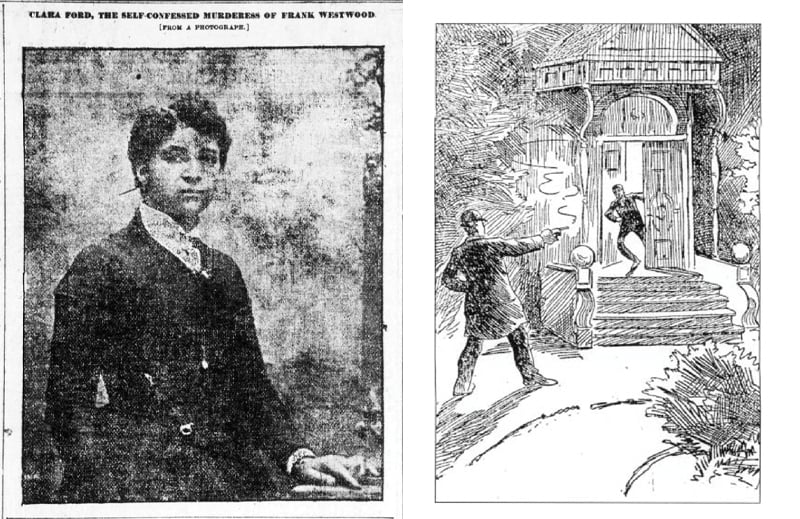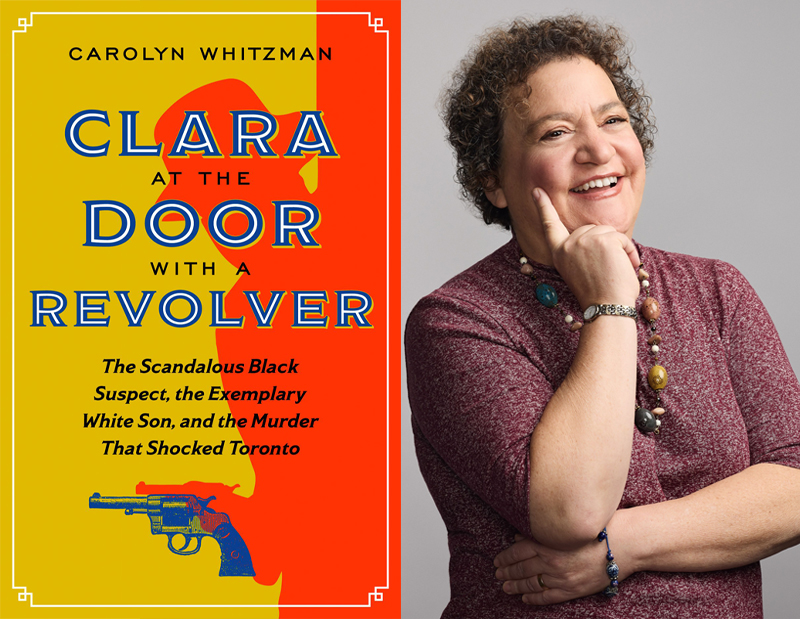
A photograph of Clara Ford from the December 1, 1894 edition of The World; an illustration purporting to show the murder of Frank Westwood from the October 8, 1894 edition of the Toronto News.
Author and urban researcher Carolyn Whitzman stumbled upon the story of Clara Ford by accident.
She was working on her PhD in housing policy in 2001, looking to dispel the myth that the west Toronto neighbourhood of Parkdale had been a stable middle-class suburb until the Gardiner Expressway was erected in the mid-20th century. While walking around the neighbourhood, she saw industrial buildings and working class dwellings from eras past, so Whitzman combed through old newspapers for evidence that people of different social classes did indeed work and live alongside each other in the community.
A 1960s newspaper story took her in another direction altogether: it brought up the case of Clara Ford as a clear example of the neighbourhood’s fine-grained social differences. Ford, a 33-year-old working-class Black woman and single mother, was accused of murder in the October 1894 death of Frank Westwood, a wealthy young white man whose family lived in a grand home in Parkdale. Ford had lived for a time in Parkdale, not far from the Westwood home, though she was living downtown at the time of Westwood’s death. At the trial, she took the stand in her own defence – only the second person and first woman to do so in Canada – and was acquitted, after testifying that she’d confessed under duress after being kept by police for hours without access to friend or counsel.
Whitzman’s interest was immediately piqued.
“I dove into the newspapers of the time and completely went down the rabbit hole,” Whitzman recalls. “My thesis advisor said, ‘Stop and go back to your thesis,’ so I did.”
She returned to her research on housing policy, but couldn’t forget the story of Clara Ford. So when Whitzman took early retirement from her position as professor of urban planning at the University of Melbourne in 2018, she came back to Ford’s story, with an inclination to turn her hand to writing of a non-academic kind.
“It was 20 years. I still hadn’t forgotten about it; I still got angry every time I saw a mention of Clara Ford that repeated certain things about her, for instance that she went around bragging about the murder,” Whitzman says. “I thought, yeah, this is the right time to be putting that book out there.”
The sources available are of varying credibility – the city’s seven newspapers in the 1890s were in competition for readership and often exaggerated or even fabricated facts to sell papers – but Whitzman tells the story in shades of grey in her new history, Clara at the Door with a Revolver: The Scandalous Black Suspect, the Exemplary White Son, and the Murder That Shocked Toronto (On Point Press/UBC Press, out now).

Carolyn Whitzman (Justin van Leeuwen)
Whitzman paints a picture not only of what most likely may have happened, but also of the lives of the people involved in the case, from the victim and the accused to the police officers, lawyers, and judge involved in the eventual trial, and even a man who probably shouldn’t have been so easily dismissed as a suspect.
There is no way to know definitively what happened when Frank Westwood was shot in his home after answering the door to a late-night visitor. He lived for several days after he was shot, and described his assailant to police as “a medium-sized, relatively heavy-set middle-aged man in a dark overcoat and fedora” with a thin mustache, Whitzman writes. Clara Ford did own men’s clothes and a revolver, things she testified she had for her own protection – a believable claim for a woman of little means and less privilege living in 19th-century Toronto.
Ford was presented in various ways in the newspapers as the case progressed, but it was always through the lens of one racist trope or another.
“The only way I could write this book is to say to myself, ‘I’m on Team Clara,’ and to try to see things from her perspective,” Whitzman says. “So little was written at the time about Clara as a mother … I tried to sit with what we know and work out how it must have felt for Clara as a mother to know that she needed to constantly go away – at one point, to live as a servant in someone else’s house – in order to support not just her mother but also her children. That’s appalling.”
Mentions of the Clara Ford case still pop up occasionally in contemporary newspapers – with the prevailing narrative based largely on the account of Hector Charlesworth, who was a young reporter at The World at the time of Westwood’s death. In his memoir published decades later, Charlesworth openly admits to fabricating stories to sell newspapers.
“This is the guy they’re depending on; he himself is saying, ‘I make stuff up, that’s my living,’” Whitzman says. “You open up [Clara at the Door with a Revolver] thinking it’s going to be about Clara Ford, and then it ends up being about the nature of truth.”
For her part, when she sees contemporary news stories discussing the case and relying on Charlesworth’s account, Whitzman is ready to defend Ford’s reputation. After The Toronto Star published a story in 2022 that based its telling of the tale on Charlesworth’s account, Whitzman emailed the public editor to complain. So, it is fitting that an excerpt from her book, which she writes is “an attempt to extricate Clara’s life from 125 years of societal coding intended to determine the ‘place’ of a Black woman in the Canadian city,” ran in that newspaper earlier this month.
 Contact us via email
Contact us via email
